| کد مقاله | کد نشریه | سال انتشار | مقاله انگلیسی | نسخه تمام متن |
|---|---|---|---|---|
| 797243 | 1467056 | 2016 | 50 صفحه PDF | دانلود رایگان |
We argue in favor of representing living cells as automata and review demonstrations that autonomous cells can form patterns by responding to local variations in the strain fields that arise from their individual or collective motions. An autonomous cell's response to strain stimuli is assumed to be effected by internally-generated, internally-powered forces, which generally move the cell in directions other than those implied by external energy gradients. Evidence of cells acting as strain-cued automata have been inferred from patterns observed in nature and from experiments conducted in vitro. Simulations that mimic particular cases of pattern forming share the idealization that cells are assumed to pass information among themselves solely via mechanical boundary conditions, i.e., the tractions and displacements present at their membranes. This assumption opens three mechanisms for pattern formation in large cell populations: wavelike behavior, kinematic feedback in cell motility that can lead to sliding and rotational patterns, and directed migration during invasions. Wavelike behavior among ameloblast cells during amelogenesis (the formation of dental enamel) has been inferred from enamel microstructure, while strain waves in populations of epithelial cells have been observed in vitro. One hypothesized kinematic feedback mechanism, “enhanced shear motility”, accounts successfully for the spontaneous formation of layered patterns during amelogenesis in the mouse incisor. Directed migration is exemplified by a theory of invader cells that sense and respond to the strains they themselves create in the host population as they invade it: analysis shows that the strain fields contain positional information that could aid the formation of cell network structures, stabilizing the slender geometry of branches and helping govern the frequency of branch bifurcation and branch coalescence (the formation of closed networks). In simulations of pattern formation in homogeneous populations and network formation by invaders, morphological outcomes are governed by the ratio of the rates of two competing time dependent processes, one a migration velocity and the other a relaxation velocity related to the propagation of strain information. Relaxation velocities are approximately constant for different species and organs, whereas cell migration rates vary by three orders of magnitude. We conjecture that developmental processes use rapid cell migration to achieve certain outcomes, and slow migration to achieve others. We infer from analysis of host relaxation during network formation that a transition exists in the mechanical response of a host cell from animate to inanimate behavior when its strain changes at a rate that exceeds 10−4–10−3 s−1. The transition has previously been observed in experiments conducted in vitro.
Journal: Journal of the Mechanics and Physics of Solids - Volume 87, February 2016, Pages 177–226
